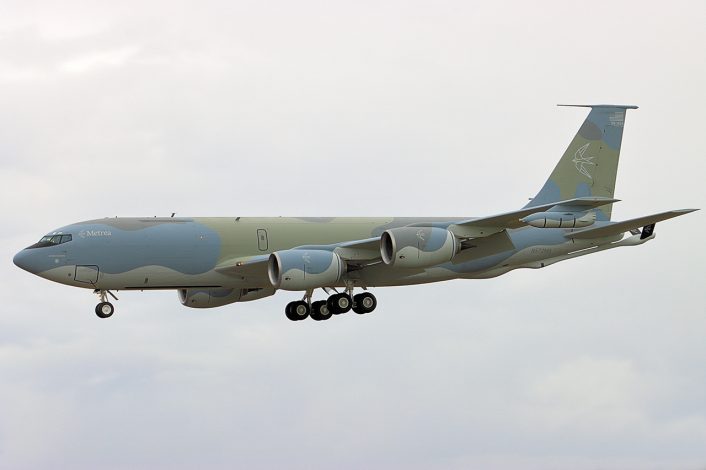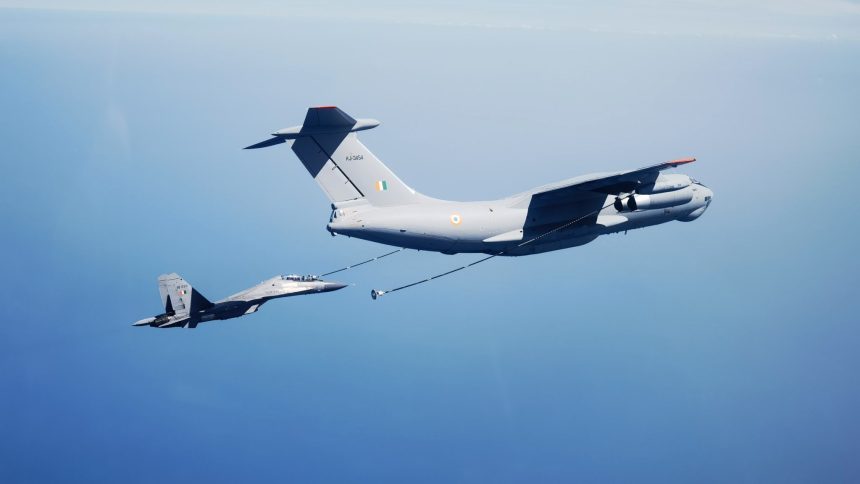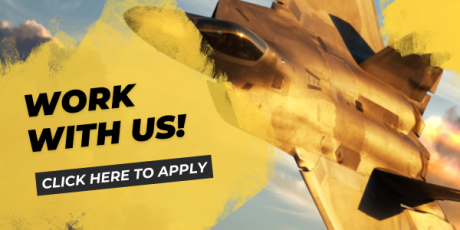Tankers will be leased from the French Air Force and private company Metrea while the Indian Air Force finalizes plans for a long-term solution.
India’s fleet of Ilyushin Il-78MKI tankers, introduced in 2003, have long been plagued with reliability issues. From troublesome refueling pods to difficulty sourcing spares and manufacturer support, and even questions over the airframes’ airworthiness, between 2010 and 2016 the fleet’s availability rate was calculated at 49%. Far below the Indian Air Force’s target of at least 70% availability, it has sought new aircraft on several occasions but the contracts have always failed to materialize.
On Mar. 28, 2025, the Indian Ministry of Defence announced that a contract had been signed with military contracting company Metrea for the supply of a KC-135 Stratotanker refueling aircraft. The wet lease contract will see Metrea provide the aircraft along with crew and maintenance support, commencing within six months. It will operate with both Indian Air Force and Indian Navy pilots to support air to air refueling training.

The same day, Scramble reported that the Indian Ministry of Defence had also given its approval to a lease which will secure an Airbus A330 MRTT refueling aircraft from the French Air Force for a period of three years. This contract will also be a wet lease, although it is intended to additionally provide Indian Air Force personnel experience with the A330 MRTT platform as it has long been the service’s preferred choice for a future tanker. The deal will be finalized during the next financial year, which begins in April.
Reports that India has been in negotiations for such a lease have swirled through the aviation industry for several years. Air Force officials are said to believe the MRTT is the natural option for India, especially after the nations’ Rafale fighters were delivered using A330 MRTTs from France and the United Arab Emirates as refueling support.
Rafales were refueled in-flight by UAE Air Force tankers. This marks yet another milestone in the strong relationship between the two Air Forces.
Thank You UAE AF.@IndembAbuDhabi @Indian_Embassy pic.twitter.com/6gFwh0AnjR
— Indian Air Force (@IAF_MCC) March 31, 2021
Further signaling their preference for the MRTT, in November 2024 an agreement was signed with Australia that will see the latter’s A330 MRTTs (designated KC-30A) support some Indian Air Force operations.
Even though the air force’s desires are clear, complicated procurement rules have hampered every procurement attempt so far. Bids from Airbus, Boeing, and Ilyushin are all considered through a process that prioritizes lower costs above all other factors.
In 2022, Indian aerospace firm Hindustan Aeronautics Limited (HAL) signed a memorandum of understanding with Israel Aerospace Industries (IAI) for the conversion of Boeing 767s into refueling platforms. No further news regarding this seems to have been released, but presumably it will be tabled as an option in any future procurement competition held by the Indian Air Force.
Stopgap Measure
While the provision of two leased tankers is unable to completely fulfil all of the operational taskings of India’s entire fleet of six Il-78s, they will at the very least ease the burden on a clearly struggling tanker force. With a less demanding training schedule, it is possible that some progress can be made on improving aircraft availability.
🇮🇳 Indian Air Force Il-78MKI KJ-3449 #8002D6 on final to McChord Field (KTCM) on May 28, 2024.
The tanker along with 4 Rafale fighters and a C-17A stopped on the 28th at McChord before moving on to Eielson the next day for Red Flag Alaska 24-2. @IAF_MCC https://t.co/psrt33AMwN pic.twitter.com/QrMdl8q3s9
— Evergreen Intel (@vcdgf555) June 5, 2024
As a geographically large nation with a growing air force, India’s air-to-air refueling requirements are unlikely to stop increasing any time soon. Already, with their Il-78 fleet, the air arm has sent fighter aircraft on long range deployments overseas for exercises with allies.
India’s tankers support the combined Air Force and Navy fighter fleets, which number a few hundred aircraft of varying types including Rafale, Su-30MKI, MiG-29, Tejas, Jaguar, and Mirage 2000. They can also refuel India’s Embraer R-99s, equipped with the locally produced DRDO Netra airborne early warning and control system.
Great Milestone: IAF’s Embraer aircraft with Airborne Early Warning and Control System (mini-AWACS) successfully carried out Air to Air Refuelling from an IL-78 to fly a long duration mission pic.twitter.com/5kd3pHJpqB
— Rajat Pandit (@rajatpTOI) November 30, 2017
However, the Il-78s are unable to offload fuel to India’s P-8I Poseidon maritime patrol aircraft due to the type’s use of the boom refueling system, rather than probe and drogue. Both the French Air Force’s MRTTs and Metrea’s KC-135s are equipped with refueling booms, giving India the possibility of extending the P-8s’ already impressive range even further for the first time.
Long range maritime patrol in particular is a strategic necessity for India due to the threat of piracy in the Indian Ocean, as well as the requirement to monitor regional rival China’s expanding naval activities.
Interesting map of Indian Air Force’s long range missions (using combat aircraft not just reconnaissance). The Djibouti mission shows deep combat coverage over Arabian Sea, and if needed, Persian Gulf. Adds an air component in theory to increasing naval presence. @IAF_MCC pic.twitter.com/PsKbRVwAgf
— Kabir Taneja (@KabirTaneja) October 3, 2023
Geopolitical Constraints
India’s eclectic mix of defense equipment from the United States, Europe, Russia, and Israel, as well as domestically produced products, provide a very interesting case from an analysis perspective. In very few other places one would be able to see equipment from all of these nations in service at the same time, even on the same vehicle.
BrahMos, the formidable weapon of the Indian Navy’s surface fleet, is deployed on twelve (12) destroyers and ten (10) frigates, with a total arsenal of 232 missiles! 😮
*INS Udaygiri and INS Tamala are included as they are set to join the Fleet this year. pic.twitter.com/bNdcr9M0Vx
— Naval Analyses (@D__Mitch) February 10, 2025
For example, on the Indian Navy’s Visakhapatnam class destroyer, locally produced Italian OTO Melara 76 mm cannons, widely used across NATO, are fitted forward of vertical launch system (VLS) cells containing the Russian-Indian joint venture BrahMos anti-ship missile. Behind these are Barak 8 anti-air missiles, developed in conjunction with Israel. On the main mast sits four Israeli designed MF-STAR AESA radar panels, while on the rear mast a licensed version of a Thales L-Band radar provides long range 2D search.
These design choices still stem from India’s policy of non-alignment, which it held throughout the Cold War. Forging a third path and refusing to align with either the Western bloc or the Eastern bloc, India’s military sought equipment from an eager to sell Soviet Union as well as from the familiar offerings of the United Kingdom.
India gained its independence from the UK in 1947, and although subsequent relations were not always on the best of terms, the former colony remained a reliable customer. English Electric Canberras, Hawker Hunters, and SEPECAT Jaguars flew alongside Sukhoi Su-7 Fitters, Mikoyan-Gurevich MiG-25s, and Antonov An-12s, all wearing Indian colors.
Did you know that the #Indian Air Force is the world’s sole remaining operator of SEPECAT Jaguar? The country maintains an active fleet of 130 aircraft. Btw Jaguars along with Mirage-2000s are the only two aircraft types in IAF service cleared for nuclear weapon delivery.#AvGeek pic.twitter.com/Kkz6oPq2cc
— Air Power (@RealAirPower1) September 11, 2021
India still maintains cordial relations with Russia, despite the latter drawing international condemnation for its invasion of Ukraine. The Indian military still receives deliveries of new equipment from Russia, making the idea of being cut off from long term supplies and support a daunting prospect.
U.S. President Donald Trump is the latest Western leader to attempt to lure India away from Russian ties, and remove one of the few remaining sources of overseas sales for Russian defense products. In February, in what may have been an unplanned off-the-cuff remark, Trump stated he would be willing to sell Lockheed Martin F-35s to India in the future. He also claims military sales to India would be increased in general.
Previously, the U.S. has been unwilling to sell F-35s to nations with close ties to Russia, fearing that data related to the aircraft may be compromised by the Russian-produced equipment operated by these countries. Most famously, Turkey was removed from the F-35 program over its acquisition of the Russian S-400 surface to air missile system.
Whether these considerations are now weighed differently given changing global situations will only become apparent in the years to follow.









